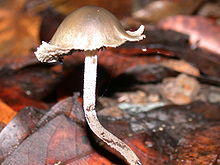| Panaeolus acuminatus | |
|---|---|
 | |
| Scientific classification | |
| Kingdom: | |
| Phylum: | |
| Class: | |
| Order: | |
| Family: | Bolbitiaceae |
| Genus: | |
| Species: | P. acuminatus |
| Binomial name | |
| Panaeolus acuminatus | |
| Synonyms | |
| Panaeolus rickenii | |
| Panaeolus acuminatus | |
|---|---|
| Mycological characteristics | |
| gills on hymenium | |
| cap is convex | |
| hymenium is adnexed | |
| stipe is bare | |
| spore print is black | |
| ecology is saprotrophic | |
| edibility: unknown | |
Panaeolus acuminatus, also known as Panaeolus rickenii is a common little brown mushroom.
This species contains small amounts of serotonin (licit tryptamine), 5-HTP, and tryptophan.
Description
This is a little brown mushroom that grows on dung and has black spores. It has a cap that is less than 4 cm across, hygrophanous, conic to campanulate to plane, usually with an umbo. The gills are dark purplish black, crowded, with several tiers of intermediate gills. The spores are (11) 13 - 15 (17) x 9 - 11 (12) x (6.5) 7 - 8 (9) micrometers, smooth, black, and shaped like lemons.[1] Cheilocystidia present.
Habitat and distribution
Panaeolus acuminatus is a mushroom that grows in grass and in dung. It has been found throughout North America and Europe and is very widely distributed.
See also
References
- ^ Gerhardt, E: Taxonomische Revision Gattungen Panaeolus und Panaeolina, page 73. 1996
External links